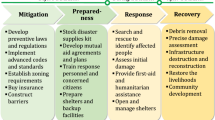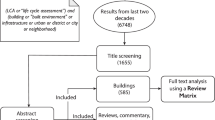Abstract
The modern society has been developing new paradigms in diverse fields through IT convergence based on information technique development. In the field of construction/transportation, such IT convergence has been attracting attention as a new generation technology for disaster prevention and management. Researches on disaster prevention and management are continuously being performed. However, the development of safety technology and simulation for prediction and prevention is comparatively slow. For the new generation IT convergence to efficiently secure safety and manage disaster prevention, it is more important than anything else to construct systematic disaster prevention system and information technology. In this study, we suggested the associative context mining for ontology-driven hidden knowledge discovery. Such method reasons potential new knowledge information through the association rule mining in the ontology-driven context modeling, a preexisting research, and uses the semantic reasoning engine to create and apply rules to the context simulation. The ontology knowledge base consists of internal, external, and service context information such as user profile, weather index, industry index, location information, environment information, and comprehensive disaster situation. Apriori mining algorithm of the association rule is applied to reason the potential relationship among internal, external, and service context information and discovers and applies hidden knowledge to the semantic reasoning engine. The accuracy and validity are verified through evaluating the performance of the developed ontology-driven associative context simulation. Such developed simulation is expected contribute to enhancing public safety and quality of life through determining potential risk involved in disaster prevention and quick response.










Similar content being viewed by others
Notes
EDIS, http://hisz.rsoe.hu/.
GDACS, http://www.gdacs.org/.
Jena 4.0, http://jena.apache.org/.
References
Lee, C.H., Oh, K.R.: A study on building public broadcast system for disaster. J. Korean Soc. Hazard Mitig. 14(4), 155–161 (2014)
Kim, S.H., Chung, K.: 3D simulator for stability analysis of finite slope causing plane activity. Multimed. Tools Appl. 68(2), 455–463 (2014)
Fullerton, C.S., Ursano, R.J.: Post Traumatic Stress Disorder: Acute and Long-Term Responses to Traumatic and Disaster. American Psychiatric Press, Washington, DC (1997)
Kim, J.C., Jung, H., Kim, S.H., Chung, K.: Slope based Intelligent 3D disaster simulation using physics engine. Wirel. Pers. Commun. 86(1), 183–199 (2016)
Chung, K.Y.: Recent trends on convergence and ubiquitous computing. Pers. Ubiquitous Comput. 18(6), 1291–1293 (2014)
Chun, H.W.: Disaster prevention information technology. Electron. Telecommun. Trends 28(2), 145–154 (2013)
Lee, J.A.: It utilizes the ubiquitous disaster response system status and challenges. IT Policy Research Series, No. 5 (2008)
Barry, A., Nick, F.: Man-Made Disasters. Butterworth-Heinemann, London (1997)
Yoo, Y., Yeo, M., Kang, M.: Trend analysis of global public safety communicators & PS-LTE. Rev. Korean Soc. Internet Inf. 16(1), 33–38 (2015)
Jung, H., Chung, K.: Ontology-driven slope modeling for disaster management service. Clust. Computing 18(2), 677–692 (2015)
Oh, J., Kim, J.: Real time disaster management system using the location awareness service. Mag. IEEK 35(12), 94–109 (2008)
Kim, D., Kim, J., Do, T.T., Chong, P.K., Yoo, S., Sung, J., Sanchez Lopez, T., Kim, D., Kim, H.: Hareubang project : disaster prevention service based the USN embedded System. J. Korean Inst. Commun. Sci. 23(5), 114–126 (2006)
Seo, T., Jung, D., Jeong, M., Kim, C.: Design of cyber disaster management system using IT conversions technology. In: Korean Society For Internet Information, pp. 811–815 (2010)
Han, J., Pei, J., Yin, Y., Mao, R.: Mining frequent patterns without candidate generation: a frequent-pattern tree approach. In: Workshop on Data Mining and Knowledge Discovery, vol. 8, pp. 53–87 (2004)
Nguyen, D.T., Hwang, D., Jung, J.J.: Time-frequency social data analytics for understanding social big data. Intell. Distrib. Comput. VIII 570, 223–228 (2015)
Cho, D.J., Rim, K.W., Lee, J.H., Chung, K.Y.: Method of associative group using FP-Tree in personalized recommendation system. J. Korea Contents Assoc. 7(10), 19–26 (2007)
Jung, H., Chung, K.: Sequential pattern profiling based bio-detection for smart health service. Clust. Comput. 18(1), 209–219 (2015)
Agrawal, R., Srikant, R.: Fast algorithms for mining association rules. In: Proceedings of the 20th International Conference on Very Large Databases, pp. 487–499 (1994)
Agrawal, R., Imielinski, T., Swami, A.: Mining association rules between sets of items in large databases. In: Proceedings of ACM SIGMOD on Management of Data, pp. 207–216 (1993)
Clifton, C., Marks, D.: Security and privacy implications of data mining. In: Workshop on Data Mining and Knowledge Discovery, Montreal, pp. 15–10 (1996)
Chung, K., Kim, J.C., Park, R.C.: Knowledge-based health service considering user convenience using hybrid Wi-Fi P2P. Inf. Technol. Manag. 17(1), 67–80 (2016)
Kim, S.H., Chung, K.: Emergency situation monitoring service using context motion tracking of chronic disease patients. Clust. Comput. 18(2), 747–759 (2015)
Jung, H., Chung, K.: Life style improvement mobile service for high risk chronic disease based on PHR platform. Clust. Comput. 19(2), 967–977 (2016)
Jung, H., Chung, K.: Knowledge based dietary nutrition recommendation for obesity management. Inf. Technol. Manag. 17(1), 29–42 (2016)
Kim, J.H., Chung, K.Y.: Ontology-based healthcare context information model to implement ubiquitous environment. Multimed. Tools Appl. 71(2), 873–888 (2014)
Ha, Y., Park, K.: A study on game physics engine focused on real time physics. J. Korean Soc. Comput. Game 9(5), 43–52 (2009)
Chao, F., Yao, X.: Simulation of landslide based on physical engine. In: Proceedings of the International Conference on Information Science and Engineering, pp. 6899–6902 (2010)
Silén, C., Wirell, S., Kvist, J., Nylander, E., Smedby, Ö.: Advanced 3D visualization in student-centered medical education. J. Med. Teach. 30(5), 115–124 (2008)
Kim, S.H., Chung, K.Y.: Medical information service system based on human 3D anatomical model. Multimed. Tools Appl. 74(20), 8939–8950 (2013)
Chao, F., Yao, X.: Simulation of landslide based on physical engine. In: Proceedings of the International Conference on Information Science and Engineering, pp. 6899–6902 (2010)
Chung, K.: Development of Ontology based Intelligent Slide Modeling and Urban Climate Disaster Index, Final Report 14CTAP-C078863-01, Infrastructure and Transportation Technology Promotion Research Program, Korea Ministry of Land, Infrastructure and Transport (2016)
nVIDIA PhysX: http://www.geforce.com/hardware/technology/physx/
nVIDIA PhysX Particles: https://developer.nvidia.com/apex-particles/
Author information
Authors and Affiliations
Corresponding author
Rights and permissions
About this article
Cite this article
Jung, H., Yoo, H. & Chung, K. Associative context mining for ontology-driven hidden knowledge discovery. Cluster Comput 19, 2261–2271 (2016). https://doi.org/10.1007/s10586-016-0672-8
Received:
Revised:
Accepted:
Published:
Issue Date:
DOI: https://doi.org/10.1007/s10586-016-0672-8




